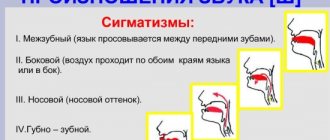In Iktor Dragunsky wrote a funny story “The Enchanted Letter”. Three friends Alyonka, Mishka and the author (as children) saw a truck bring a Christmas tree into the yard. The girl exclaimed enthusiastically: “Look, there are detectives hanging on the tree.” The boys laughed - Alyonka was offended and began to make excuses that the tooth had fallen out, that’s why she said “detective”
.
To which Mishka answered her: “I have three that fell out, and two are wobbly, but I still say it correctly!” Listen here: giggles!
“The guys began to argue until they cried over who was right.
The author of the story, looking at them, laughed for a long time. On the way home, he thought: why were his friends arguing, because the word is simple: “There are no detectives
.
No naked
, but briefly and clear:
Fyfki
! "
The guys, of course, spoke correctly, they just mixed up some sounds.
Perhaps, many parents also noticed that their kids replace whistling ones with hissing ones (shanki - sleds) and vice versa (detectives - shishki). This lack of pronunciation of whistling sounds (S-S', Z-Z', C) and hissing sounds (Ш, Ж, Х, Ш) is called sigmatism. Both groups of sounds appear by 4-5 years. Hissing sounds are considered more complex in articulation and are placed after whistling sounds. A speech therapist corrects pronunciation. But any training with a specialist is reinforced at home. In this article we will tell you about important steps that will help your child disenchant S and Sh faster.
Articulation gymnastics for whistling sounds
1. Lip exercises.
- “Smile” - stretch your lips into a smile as much as possible. The teeth should be closed. Hold your lips in this position for several seconds. Repeat several times.
- “Tube” - the teeth are closed, the lips are pulled forward.
2. An exercise to develop an air stream - be able to forcefully blow air through your lips, folded into a tube. The air stream should be sharp and cold. Repeat several times.
- “Football” - you need to take a small piece of cotton wool. This will be the ball. Set up an improvised gate. The child must blow forcefully on the cotton wool and try to score a goal. Monitor the direction of the air stream. She should be strong, cold, lips like a tube.
3. Exercises for the tongue.
- “Let’s brush your lower teeth” - smile, open your mouth slightly, use the tip of your tongue to “brush” your lower teeth from the inside, moving your tongue from side to side.
Stage 2: selecting correction techniques
Correction depends on the shape of the defect. We will talk about universal techniques that can be used for staging in any case. These include imitation, the use of reference sounds and mechanical influence.
Imitation technique
Imitation training is effective for minor defects in sound pronunciation in children. Show your child how to pronounce the hard sound “s” correctly. To do this, sit both in front of the mirror so that he can see both himself and you. Next, give your child the following instructions:
- Open your mouth and smile.
- Spread the tongue, tense its tip and rest it on the lower teeth (incisors).
- Let the “breeze” pass through your tongue. The result should be "c".
Young children absorb information and master skills better through play. Come up with them for your child! For example, you can pump up a bicycle tire, deflate a balloon, blow into a bottle with a narrow neck, or blow like a sea breeze - all these actions are accompanied by the sound "sssssss."
Technique of staging from reference sounds
If the child pronounces other sounds well, you can build on them. In the case of sigmatism, the reference sounds are the soft “s” and the interdental “s”.
We use the soft sound “s”.
First, ask your son or daughter to pronounce the sound “s” and see where the tongue is located at this time - the correction depends on this.
- The tongue is located at the top - it rests on the incisors. You can teach your child the correct pronunciation of sounds. To do this, the adult opens his mouth and says “s”, the baby watches and repeats after him.
- The tongue is located below - rests on the teeth. The child is taught to pronounce “s” from the correct articulatory position - the tip of the tongue is on top.
When the baby has learned this, the skill needs to be finally consolidated. This is facilitated by staging exercises.
We pull the sound . The baby smiles and says “s” for a long time. At this time, he himself or the adult below puts his palm to his mouth. When making sounds, slightly cool air should flow.
Rounding the lips . Continuing to do the exercise and holding his palm to his mouth, the baby rounds his lips and pulls them into a tube, as if to pronounce “y”. An adult can show by example how this is done. The mouth should not be opened wide.
We monitor the air . The main condition is that the air flow must be continuous when performing all actions. Moreover, it gets warmer over time.
We reach a solid “c”. If the baby is unable to pronounce it automatically, the adult explains that the task now is to “warm up” the air in the palm. Then everything will work out.
We say "su" . This is an auxiliary exercise that will help your child achieve the desired hard “c”. We monitor the hot air.
We say a hard “s” . As soon as the result is obtained, show with your example: move your lips forward, as if you are going to say “y-y-y-y”, clench your teeth. This will “affirm” the “s” even more. If the baby presses his tongue tightly against his upper teeth, it will be even easier for him.
We consolidate the result. Introduce the learned sound in syllables with all vowels.
We start from the interdental reference sound “s”
Does the baby stick his tongue between his teeth, pronouncing “s”? Look where exactly the tongue is located:
- There is a “groove” along the tongue; the baby places the tongue between the teeth. Show your child how to hide it behind his teeth and say “s” yourself so that the baby can see;
- There is no “groove”, the tongue is flat. First of all, you need to establish correct interdental sound pronunciation. An adult should not say “c” out loud.
In this case, the following step-by-step production of the sound “s” is used.
Correct articulatory posture . The student needs to spread it out and stick it between his teeth. Move the tip of the tongue forward or position it at the level of the incisors. Then smile widely with closed lips and, ideally, bite the sides of the tongue.
We blow into our palms. The main thing is that the air stream should be as cold as possible. This will create the necessary “groove”. The baby should smile continuously; you can hold the upper lip with your finger - this will make it easier. If he does everything correctly, a whistling sound will be heard.
We whistle like a mosquito . Sit the baby in front of the mirror, show him the “groove” and explain that thanks to it the baby can whistle. But that’s how a big mosquito whistles, and you need to learn to speak like a small one - in a thin voice.
Finally we put “c”:
- The student continuously “whistles.” It is better if he controls this process by looking in the mirror. The main thing is that the “groove” must remain in place.
- Slowly removes the tongue behind the upper incisors and presses it against them from the inside. The adult shows how to do this, but does not say “s”.
- The baby almost achieves the correct sound pronunciation. Then he opens his mouth and the correct pronunciation is heard.
When the student correctly pronounces “s” in isolation, begin to introduce it into speech: first in syllables, then in words.
Mechanical impact
For setting, use counting sticks, blunted toothpicks, matches - any of the listed tools will do.
One of the ways is this. The baby places his wide tongue below, its tip resting on the lower incisors. An adult places a match in the middle of the tongue. After this, the child brings his palm to his mouth, bites the match and smoothly but forcefully blows out air so that he can feel it on the skin of his palm.
If “s” is heard at the same time, it is practiced with a match, and then without it.
Here are a few points to keep in mind when doing the “c” exercise:
First, insert the match into the baby’s mouth 2 cm, and if the tongue dodges, a little deeper.
Secondly, when pressed with a match, the little student begins to whistle with a “lisp.” Ask him to press his lips together so that only the match passes through, but do not let him bite it. The tongue remains in the mouth behind the teeth. The baby blows on the tip of his tongue so that the exhalation passes between the teeth.
Thirdly, control the pressure with the match. Try pressing harder or weaker, deeper or at the very tip of the tongue - this way you will find the position in which your child will get the perfect sound pronunciation.
Fourth, when you place the isolated “s” sound, begin to introduce it into speech. First - into syllables, and then into words. If the baby makes a mistake again when pronouncing the words, connect the match.
Engage with your child in the form of a game: draw analogies with cartoon characters, show pictures, interesting stories.
Stage 3: automation, or consolidation
Mastering correct sound pronunciation in isolation from speech is only the first stage of learning. Next, it is important to consolidate it and bring it to such automatism that the child correctly pronounces the new sound in words and phrases.
First work on the production in syllables, then in words, with “s” at the beginning, middle and end of words. After that, move on to proposals.
Speech exercises to reinforce the pronunciation of the sound “C”
Pronouncing the hard sound “S” in straight syllables
1. Pronounce or read the syllables, extending the “s” sound:
- “sa-sa-sa”; “sy-sy-sy-sy”; “su-su-su-su”; “so-so-so-so.”
- “sa-sy-so-su”; “sy-so-su-sa”; “so-su-sa-sy”; “su-sa-sy-so.”
2. Game “Memorize and repeat”:
- “sa-sa-so”; "so-sa-so"; "so-sa-ea"; “sy-sa-sy”; “sa-sy-sy”; “sa-sy-sa”; “sa-sa-sy”; “sy-so-su”; “su-ey-su.”
3. Repeat the nursery rhyme and remember it:
- Sa-sa-sa - here comes the fox.
- So-so-so - she rolls the wheel.
- Sy-sy-sy - a fox has a red tail.
- Su-su-su - we are not afraid of the fox.
Pronouncing syllables
- “So”: juice, catfish, sleep, Sonya, soda, falcon, litter, hill, barefoot, oblique, sand, sock, forest, belt, spikelet, wheel, bean, tall, sedge.
- “Sa”: himself, garden, lard, sleigh, Sasha, sugar, cod, sleigh, wasp, fox, braid, dew, bite, write, beauty, sausage, stripe, sambo, landing, mustachioed, kindergarten, write.
- “Su”: soup, bough, court, bag, vessel, dishes, carry, draw, carry, vessel.
- “Sy”: cheese, son, owl, full, scales, mustache, noses, scarf, parcel, rash, mound.
Pronunciation of words
1.With unstressed syllables:
- Salad, gardens, boot, fireworks, cash register, mass, plane, sundress, Larisa, rat, be able to, chest, souvenir, cheese, son, raw, wasps, beads, rails, hair, blond, send.
At this stage, it is recommended to use visual material, card indexes of subject pictures, and playful work techniques.
2. Pronounce the syllables correctly:
- “ska-sko-sku-sky”; “sla-slo-slu-sly”; “sma-smo-smo-smy”;
- “swa-swo-swo-swa”; “spa-spo-spo-spa”; “hundred-hundred-stu-sty.”
3. Read or say “difficult” words - with a combination of consonants:
- Pile, dump, dump, your, firmament; rolling pin, roll down, tablecloth, bench, fast, Glory, sweet, elephant, word, hearing; could, we can, wash away, dare, sheaf, again, dreams; sleep, dispute, sport, satellite, confuse, camp, steel, put, put, old man, glass, get, stand up; one hundred, table, so much, stand; tincture; chair, knock, steps, offense, deed.
Forms of sigmatism
Sigmatism is a defect in the pronunciation of hissing and whistling sounds, in our case “s”. There are 4 forms of violation.
The first is sigmatism itself, when “s” is absent from speech.
The second is parasigmatism, that is, when “s” is replaced with another sound.
Variants of parasigmatism:
- on “f” - labiodental;
- on “t” - toothed;
- on "sh" - hissing.
The third is the distortion of the “s” sound. There are several options: interdental (the child has a lisp, instead of “s” you hear “sh”), lateral (instead of “s” you hear “lkh”) and nasal (instead of “s” you hear a grunting or snoring sound, vowels are pronounced in a nasal voice).
The fourth is softening the hard sound “s”. It turns out like this: instead of the syllable “sa” - “sya”, “so” - “syo”, “su” - “syu”, “s” - “sya”.
Speech problems in children
Speech disorders in children can be caused by the following reasons.
Phonetic underdevelopment
Perhaps the most common type of violation is the incorrect pronunciation of one or more sounds. Before a speech therapist, you can visit an orthodontist - sometimes the problem can be solved by cutting the frenulum.
Phonetic-phonemic underdevelopment
With such a violation, the baby cannot even hear the sound correctly. Difficulties arise with speech, writing, and learning languages. Ask your child to repeat after you the chains of words: “dom-som-kom-lom” or syllables: “gu-ku-gu-ku.” If he makes a mistake, this is a warning sign.
General underdevelopment
Poor vocabulary, difficulty expressing thoughts, inability to write a description of a picture... As a rule, such children begin to speak later than their peers. They find it difficult to concentrate and remember. In addition to a speech therapist, you will most likely need a neurologist.
Pathologies associated with injuries, heart defects, damage to the nervous system
Examples of such pathologies include alalia, aphasia and dysarthria.
Alalia occurs due to damage to the nervous system. The child speaks very poorly, and his speech is meaningless, or he does not speak at all. Also, sometimes a baby may suffer from movement disorders, hyperactivity, or, conversely, retardation.
If alalia implies that speech initially develops incorrectly or does not develop, then aphasia is an acquired disorder. It can be caused by damage to the cerebral cortex, head injuries, and heart defects. With aphasia, children do not understand other people's speech and do not control their own, do not remember words well, and change sounds and syllables.
Dysarthria is a relatively rare disorder in which a person's speech is slurred and slurred. Dysarthria is provoked by disturbances in speech breathing and articulation, which are associated with lesions of the nervous system.
Such problems need to be dealt with comprehensively - with the help of neurologists, teachers, psychologists and speech therapists.
How to create an activity at home?
The main principles of homework:
- Regularity. Exercise every day, but without overloading the baby and taking into account his age and well-being. You can start with 3-5 minutes a day, gradually increasing to 15-25.
- Game form. Only you know what your child will like most: retelling an interesting story or a competition to see who can pronounce a tongue twister the fastest. Start with tasks that are more interesting to your baby, gradually moving on to less exciting ones.
- Comfortable environment. For many types of activities you need, at a minimum, a table, a comfortable chair, and often a mirror on a stand.
- Patience. It is impossible to achieve amazing results in one mini-lesson. Encourage your child, praise him for successes and don’t get angry for mistakes, don’t laugh or imitate. Otherwise, the baby will withdraw into himself, and speech problems may worsen.
- Do not do tasks for your child if he cannot cope with them. The point of the classes is to benefit the baby, and not to impress the speech therapist.
Important Rules
Before you start producing any sound, you need to understand some points. You can’t try to “skip” one stage and move on to the next. In this case, it will not be possible to correct the defect.
It is necessary to devote time to articulation and breathing exercises. Dynamic exercises are performed to a count of ten, static exercises to a count of five. Execution rules:
- strictly in front of the mirror;
- The child’s attention is focused on the correct posture;
- do it every day.
With dysarthria, it may take several months to practice the correct movements. There is no need to rush into staging. In severe cases, drug therapy is used to correct increased or decreased tone. Physiotherapy can also help speed up the process.
Correct articulation
Any work begins with the child being shown a sound sample. The sound [K] belongs to the group of back-lingual sounds, that is, to pronounce them, the back of the tongue rises. It is from this sound that the rest - [X], [G] and their soft pairs - are made.
Therefore, it is advisable to start the correction with the sound [K]. To pronounce it, the lips take a neutral position or become open. The teeth are open, the tip of the tongue lies at the lower teeth, but does not rest against them. The front and middle backs are lowered, the back ones are raised and rest against the soft palate. The sides of the tongue lightly touch the hard palate. The vocal cords do not tense, the air passes through the closure of the tongue and palate, breaks it and the sound [K] is produced.
Normally, the posterior lingual group appears at an early age. Thanks to sucking, the tongue takes the form of a “slide” and the child is able to pronounce individual sounds.
Difficulties may arise due to a high or narrow palate - in this case, it will not be possible to form a bow. With dysarthria, weakness or tension of individual muscles of the tongue occurs. Sometimes children have poor phonemic hearing. Thanks to it, people distinguish between different speech sounds.
Phonemic (speech) hearing should not be confused with physical hearing! If the first is violated, the child will be able to distinguish non-speech sounds well and respond to the speech of other people, but will poorly perceive what he himself says.
Defective pronunciation of the sound [K] is called kappacism. Sometimes there is no sound, then instead of “Cat” you get “'ot”. The sound may be distorted and a click will be heard instead - this happens due to the bow being too tight.
Replacing [K] with other sounds is called paracappacism. Most often the sound changes to [G], [X] and sometimes to [T]. In this case, in addition to sound production, the speech therapist deals with differentiation.
How do you know when it’s time to work on your child’s speech?
Initially, the child learns to pronounce sounds, then to put them into words, then to construct phrases and express thoughts. You should not expect from a two-year-old child impeccably clean pronunciation and beautiful speech, observing genders and cases. In addition, until the age of three, a child will not be able to concentrate on classes for more than 10 minutes.
The optimal age for starting classes for a healthy child is four to five years. By six he should already be able to pronounce sounds correctly and express his thoughts coherently. It is better to correct the pronunciation before the molars grow in.
Classes are needed if:
- the baby pronounces individual sounds incorrectly;
- the child rearranges syllables in words, constructs phrases incorrectly, confuses cases, gender, and numbers;
- “porridge in the mouth”;
- speech is too fast, slurred;
- the child stutters;
- the baby has suffered a birth injury or infectious disease;
- The child was diagnosed with hearing impairment, mild mental retardation, and developmental delay.
Even if you are not going to take your child to a speech therapist on an ongoing basis, it is worth bringing him for a consultation - you will receive recommendations for home activities. It is also advised to show the child to a speech therapist before school, even if there are no obvious problems.
The problem of speech disorders is not always purely speech therapy - sometimes it makes sense to correct pronunciation only after treatment.
Causes of speech disorders in children
- Heredity – mental retardation, hearing impairment in parents.
- Intrauterine pathologies (the mother suffered a viral disease during pregnancy and was injured). They develop when the fetus is between 1 and 4 months old.
- Premature birth and birth injuries leading to intracranial hemorrhage.
- Diseases and injuries in the first years of life: rickets, whooping cough, meningitis, damage to the skull or palate, inflammation of the middle ear.
- Psychological reasons: parents do not communicate with the child, treat him poorly, leave him alone too often.
Results: reading th sounds in English
As you can see, there is nothing too scary about the th sound. The main thing is practice. You can save our article to bookmarks and periodically practice th sounds training over and over again. And so that nothing gets confused in your head, I propose to briefly summarize:
- The letter combination th produces 2 sounds: unvoiced / θ /, as in thanks,
and voiced / ð /, as in
that
. Remember these icons: if you come across a new word, then turn to the dictionary to find out the transcription and hear the pronunciation. - This sound is pronounced as a lisp / s / and / z / - the tongue is spread out and tense, the tip is located between the upper and lower teeth, forming a narrow flat gap between the cutting edge of the upper teeth and the surface of the anterior edge of the tongue.
- The main difficulty for us is to accustom our articulatory apparatus to this sound. Especially to pronounce it correctly during fast, fluent speech. Therefore, be sure to do some training for yourself: hum songs, practice sets of words and tongue twisters.








